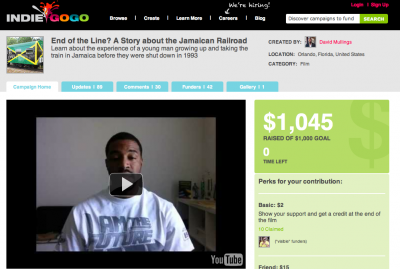
David Mullings Project on IndieGogo
With the planned return of passenger rail to Jamaica I began to speak more and more with friends about how my brother Robert and I used to take the train from Kingston to Montego Bay as children to visit our grandmother. It was surprising to find out that most of my friends had never ridden the train in Jamaica and a few didn’t even know passenger trains used to run.
I decided that I needed to tell the story of how my family benefitted from the train in Jamaica and also use this as a chance to put some of my 95 year-old grandmother’s memories on record. Being a fan of “Who killed the electric car?” I wanted to do a short-film that not only told a personal story but also asked a question and got an answer about the trains in Jamaica. It would not be a documentary about the history of rail in Jamaica but I felt that it would be good to find out of the closing of the train system in 1993 was really the end of the line.
Fate was on my side because Random Media, the integrated media company my brother and I founded in 2002 was partners with LMH Publishing for eBook distribution in the Amazon Kindle and Apple iBooks stores. That company was owned by L. Michael Henry aka the Honourable Mike Henry, Jamaica’s Minister of Transport and Works, the brains behind resuscitation of the rail network in Jamaica. I figured it would be easy to get him to do an interview for my little film project.
Now that I had the framework and the basic story we needed funding. Instead of simply paying for it out of pocket, which we could have done, I wanted to make this short-film in a way that would serve as some sort of inspiration for other young people in developing countries and especially Jamaica. Having read the story about how Minimal funded the TikTok and LunaTik iPod Nano watch products via crowdfunding on Kickstarter I decided to do the same thing.
I wanted people in developing countries and especially the Caribbean to realize that there was a source of capital and a way to get it that did not exist 10 years ago, technology had changed the way you had to go about funding a project. I settled on IndieGoGo.com because it was more geared towards creative projects like films. I had studied the keys to Minimal’s success on Kickstarter and even wrote a blog post on it so I was confident we would get our funding. I also had decided to shoot entirely on an iPhone 4 in order to add to the whole idea of technology and low cost solutions can be leveraged to achieve a goal, even one as lofty as making a short-film. I wanted people to realize how thinking creatively could be an asset and that true startup mentality is not about how much money you have but how smart you use your tools that are available.
For the budget, I calculated the bare essentials, including flight to Jamaica, having some professional help that I would pay and transportation costs. I set out to raise US$1000 in 31 days and become one of the first successfully crowdfunded Caribbean projects. Crowdfunding also had the added benefit of generating disciples who would help to spread the word about the project while we were raising money and then after the film was released since their names would be in the credits.
I raised US$1,045 from 42 in 31 days directly from IndieGoGo and another US$850 from direct contributions outside of the website for a total of US$1,945.
The film has mostly been shot and is now in post-production with plans to be released by our new RealVibez Studios imprint at the end of August. Since RealVibez is YouTube’s first official Caribbean media partner we are releasing the film on our YouTube channel (partners can upload full-length features, even as long as 3 hours) and it will be available free of charge to all for viewing.
The goal was to make one of the first crowdfunded Caribbean films using technology available to all and thereby inspire a generation of entrepreneurs and filmmakers, not to get rich. Our YouTube partnership allows us to earn advertising revenue and we also hope to leverage the “shot on an iPhone 4” aspect to secure a deal with a mobile phone company and use the money to accomplish two things: Run 1-week camps for teens interested in film and let them use iPhones to shoot and edit plus partner with JAMPRO in Jamaica to setup a fund to help finance local film projects.
People donated as little as US$2 to our project and as much as US$500 because they believed in the people behind it. I hope that my story about how I did it ends up inspiring many more people to use technolog that our parents never dreamt about and then achieve some of their dreams. Just dream big and be willing to start small.

 eCommerce4 months ago
eCommerce4 months ago
1 Comment